
by Joseph Graves | Oct 24, 2014 | Workshed News
Kickstarter is Awesome, But Not Miraculous
If you have a product you want to sell, Kickstarter is a great place to start. Maybe you need funds for the initial production run, or maybe you just want to test your concept – either way it’s a great platform. There are lots of posts and books about how to run a successful Kickstarter project, but after doubling our targeted goal for SnapLaces we did a few things a bit different than what others have recommended. Obviously every project is unique, but some of the principals we used should still be valuable.
3 Simple Lessons for A Successful Kickstarter Project
- First and foremost, we worked our asses off. Running a campaign is more than a full time job, and even with people splitting the work there was still a lot to get done.
- We didn’t discount our product. Kickstarter is the one time in a products lifecycle where people might be willing to pay more just to help you out. Don’t make the mistake of discounting just to get backers. Most people underestimate what it will take to get a product to market, and even if you don’t, unexpected things can crop up.
- We contacted everyone that backed us. Literally everyone. Their responses to our questions ultimately led to valuable insights and shaped both the tone of our campaign and the direction of our company.
A Successful Kickstarter Project is A LOT of Work
The amount of work a successful Kickstarter project requires is probably the biggest reason for failure. Having successfully managed a campaign and backed several others that were not successful, I can confidently state that there is a high correlation between the effort and result. The ones that didn’t interact with backers or actively engage, didn’t meet their funding goals.
We Didn’t Discount Our Product
Many Kickstarter projects offer discounts on the product being funded. We felt like that was a bad idea, especially at the under $50 price point we were in. We knew that we’d need over 1000 backers to be successful and lowering an already small price point would add to that number. More importantly the purpose of the campaign was to raise funds to pay for a new plastic injection mold, so we reasoned that backers would be preordering our product and helping us bootstrap the effort.
One thing we did do was offer a significant discount to a limit number of early backers to gain momentum. Your first week on Kickstarter is crucial because new projects are featured and people are much more likely to discover them. The “early adopter” reward allowed us to get the required momentum to become one on the top projects on Kickstarter which led to additional backers, but the limit made sure that we weren’t sacrificing our overall funding objectives.
Communication is Key
Prior to launching we studied other successful projects and one data point stuck out. Successful projects updated an average of 1.8 times PER DAY! This is where the bulk of the work came in. In addition to sending messages to every backer and responding to their questions, we tried to post 2-3 times every day on Kickstarter, as well as maintaining an active social media presence (active as in cultivating relationships, not just carpet bombing posts) on Twitter, Facebook, Instagram, Pinterest, LinkedIn, and Google+.
Communication is the key to success on Kickstarter.
Engage and communicate relevant information to people who have helped you (or would likely help you if only they knew you existed) is the most reliable way to have a successful Kickstarter project.
What Now?
The next project will definitely be better run and more organized, but if we can save you some time and misery by sharing than it will have been worth the time invested in reading.
As always, if you have a question or comment – just ask!

by Joseph Graves | Mar 27, 2014 | Marketing, Project Reports
 T and S was in need of a better way to represent their company online. They had great service and excellent craftsmanship, but their existing website failed to communicate that message, and they didn’t have any social media presence.
T and S was in need of a better way to represent their company online. They had great service and excellent craftsmanship, but their existing website failed to communicate that message, and they didn’t have any social media presence.
To help them we built a new, easy to navigate, responsive WordPress website on the Genesis framework. Our goal was to convey their old school values in a modern way so prospective customers could find them. We took photos of Todd and Samai on the job site, capturing them as hard-working guys they are and enabling us to avoid the cheesy stock photography you see on most websites.
In addition to a new website, we set up profiles on key social media accounts to make it easy to reach customers where they are. Rounding out the infrastructure creation, we also created a custom video intro/outro and set up their smartphones so they could record updates and share them with the world within minutes.
With their new website and social media presence, Todd and Samai wanted to make sure it didn’t go unused and retained Workshed to manage their marketing. We work with them to create content like ‘how to‘ and informational videos about the services they offer.

by Joseph Graves | Mar 11, 2014 | Articles, Marketing
Social Media Makeover
UPDATE: For the rest of March, we’re offering our social media makeover for 50% off!
Social media is one of the first places prospective clients are going to “meet” you and your company. What will their first impression be? Make sure your Facebook, Twitter, Google+, LinkedIn, and YouTube accounts (yes you should have an account on each) are sending the right message, by letting the Workshed team create a custom profile and background image for each.
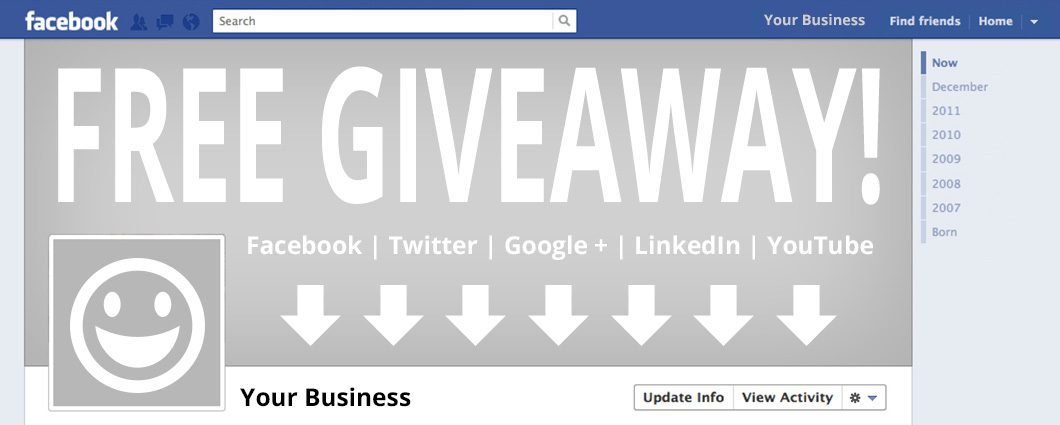
What’s it cost?
Typically we charge $500-$600 for this service, but through the end of March we’re “slashing our prices” (imagine the guy with the crazy radio voice) and offering it for $300. For those within the range of our photographer, that’s an epic deal, for the rest of you…you’ll have to settle for a great deal!
What about the free giveaway?
To enter the “Great Social Media Makeover Giveaway” is easy. Just tell us in the comments below how you currently use social media (if at all) to market your business and share this post to the social network of your choice.
Share the social media makeover




[clear]If you are selected we’ll contact you with the rest of the details.
For the forward thinking types who want to proceed with the social media makeover anyway (because it’s such a great deal, and you know how important it is) we’ll refund your payment if you are selected.
What’s Included?
Photography
If you are within 30 miles of our office, we’ll send Brady over with his fancy camera to take pictures! If you’ve ever had professional pictures taken, you know this is a screaming deal. If you are not within range of our visual arts master, we take what you have and work with it. If it’s rubbish, we’ll do something with graphics instead.
Facebook Page
Custom Profile Image
Custom Cover Photo
Google Plus Page
Custom Profile Image
Custom Cover Photo
YouTube Profile
Custom Profile Image
Custom Channel Art
Twitter Profile
Custom Profile Image
Custom Background Image
Custom Header
LinkedIn Page
Custom Header Image
Custom Standard Logo
Custom Square Logo
Universal (for your other pages)
Custom Background Image
Custom Profile Image
Share the social media makeover




[clear]
Social Media Makeover Form

by Joseph Graves | Mar 10, 2014 | Articles, Technology, Tools, Workshed News
Images are essential to an effective website. Quality photos can mean the difference between a successful website and an ugly website that burns the retinas of it’s viewers.
Photos are especially important for websites that need to communicate anything visual; such as products, artwork, or services.
Here are a couple of websites that do a great job communicating visually with images:
www.spotify.com
www.littleco.com
Not only is it important to be posting big beautiful photos, it is equally important that they are properly optimized for the web. Not having properly optimized photos means you are probably missing out on potential visitors and sales.
Do your images provide Google and other search engines with the relevant information they need to be properly indexed? If not, how are people going to find them?
Are your photos too big? If so, they could be taking longer than necessary to load on phones and other mobile devices.
Why optimize your images?
Google can’t read photos… at least not very well. This is why you need to tell Google what the image is so that Google can correctly index and organize it.
Is that another photo of your cat with sunglasses? Or is that a photo of your Grandma’s famous green jello recipe? Google doesn’t know. You need to tell it.
Here are 5 important steps to optimize images for the web:
1. Image sizes
Before your photo is posted to the world wide web, it’s important that it be the right file size. If your images are too large, your visitors are not going to wait around for your website to load; especially mobile visitors. Images that are small in file size are essential for fast page load times. Unless you have access to expensive image editing software such as Adobe Photoshop, there are plenty of free online tools to help optimize image size; here is a great one.
2. Image Title Tag
Give your image a good title tag. The title tag is what the visitor is going to see when they highlight over the image with the cursor. Wordpress makes uploading and tagging images a piece of cake. Simply type in the title tag after uploading your image:
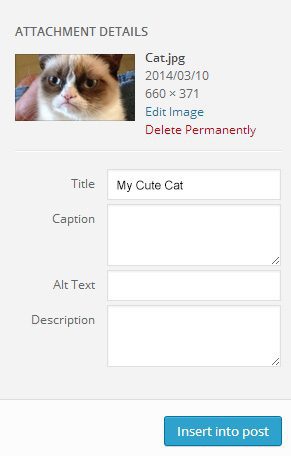
If you’re not using wordpress, and are updating your website like a dinosaur, the format goes like this:
<img src=”cat.jpg” title=”My Cute Cat”>
3. Image Caption
Add a caption tag to give your visitors a nice description or insight about your image. In WordPress, the caption is added directly underneath your image. Image captions are not used by Google, so only add if you want to give your visitors additional information.
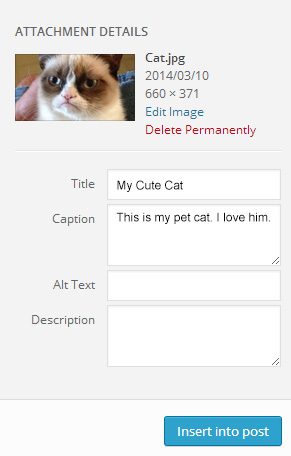
4. Image Alt Tag
The Alt tag is especially important for SEO and Google indexing. Make a habit of always putting relevant keywords that describe your image in your alt tags. The alt tag will also be displayed in place of the image if the image link breaks and cannot be displayed. WordPress also has a handy field to add an alt tag:
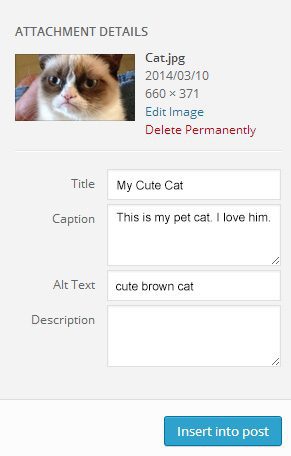
<img src=”cat.jpg” title=”My Cute Cat” alt=”cute brown cat”>
5. Image File Name
When uploading any image, make sure it has a descriptive file name. A year from now when you or a visitor are searching for a particular image, which one do you think will be easier to find?
IMG_8692.jpg or cute-brown-cat.jpg?
These are 5 great ways to help optimize your website and get more traffic. Interested in more information on maintaining an effective website, sign up for our newsletter in the right sidebar.
Have any more image optimization tips? Please leave them in the comments below!

by Joseph Graves | Mar 4, 2014 | Articles, Financial Adviser
How to Pick Your Next Blog Post Topic for Financial Advisers
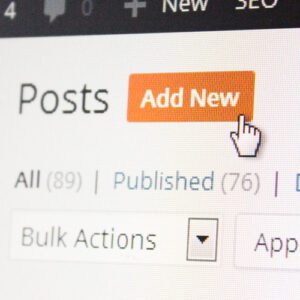 Writing a blog post with any regularity is challenging. Writing for your business needs to generate results in order to justify the investment in time and effort. A few years ago one of the companies in my portfolio was in the news and I wrote a post about my thoughts on the potential consequences. Mainly I did it because I was sick of repeating myself to clients on the phone so I thought that writing a blog post about it would save me some time. While it may have saved me a little time and prevented some boredom, it wasn’t until several months later that I discovered the real benefit.
Writing a blog post with any regularity is challenging. Writing for your business needs to generate results in order to justify the investment in time and effort. A few years ago one of the companies in my portfolio was in the news and I wrote a post about my thoughts on the potential consequences. Mainly I did it because I was sick of repeating myself to clients on the phone so I thought that writing a blog post about it would save me some time. While it may have saved me a little time and prevented some boredom, it wasn’t until several months later that I discovered the real benefit.
The Long Tail
One afternoon while I was checking my blog stats instead of making calls, I noticed some search traffic related to the investment I had written about months before. It wasn’t much, but it was the first time I’d noticed organic traffic for something so specific. For months I’d get a hit or two every few days, nothing significant, but it was consistent. I didn’t realize it at the time, but I’d stumbled on to what’s now commonly referred to as “long tail keywords.”
By this time I’d already read Chris Anderson’s book, “The Long Tail: Why the Future of Business is Selling Less of More,” but I didn’t connect the dots between selling things and search terms. Essentially its the same thing. People are searching for something they want, be it products or information. Similar to the way you can find almost any product on Amazon…Google does the same for information.
Why It Matters
Google has an army of brilliant engineers trying to make sure you get good information when using their search engine. If you write something that is relevant to a question someone asks in Google you stand a good chance of getting found…assuming the question they are asking is specific enough IE a long tail question. In the example I used earlier, the particular investment I wrote about wasn’t well known, and when people started searching about it, there wasn’t much information available so my blog post was ranked high enough in the search results to get read.
Leveraging the Long Tail
I blogged sporadically over the next few years, but in 2013 I put what I learned about long tails to good use. An investment in my portfolio was making plans to go public and the information they were providing was vague and confusing. Recalling what I had observed a few years prior, I tried to identify questions people would be asking about the investment. Whenever the company released new information, I’d write a blog post. Eventually I created a special page on my website so people could easily read through all the information I’d collected.
Yreka!
At one point in my little experiment, I was ranked on the first page in the search results and I was getting over 500 page views a day. I realize that this isn’t much traffic in the grand scheme of things, but these were people who had no idea who I was…and they were asking me for advice. Some of my posts from that period had dozens of comments which led to multiple phone conversations with people who needed my help.
Your Turn
The next time you are trying to pick your next blog post topic, be sure to check your analytics to see if there are any search terms you can use as a starting point. If you don’t have that kind of data (contact me), try to recall recent questions from clients. Is there something there you can write about?
Let me know how it works for you, I’d love to hear your stories or answer any questions.
If writing blog posts isn’t your thing that’s cool too, we’d be happy to do it for you! Email us at [email protected] and we can set up a time to talk.















 Writing a blog post with any regularity is challenging. Writing for your business needs to generate results in order to justify the investment in time and effort. A few years ago one of the companies in my portfolio was in the news and I wrote a post about my thoughts on the potential consequences. Mainly I did it because I was sick of repeating myself to clients on the phone so I thought that writing a blog post about it would save me some time. While it may have saved me a little time and prevented some boredom, it wasn’t until several months later that I discovered the real benefit.
Writing a blog post with any regularity is challenging. Writing for your business needs to generate results in order to justify the investment in time and effort. A few years ago one of the companies in my portfolio was in the news and I wrote a post about my thoughts on the potential consequences. Mainly I did it because I was sick of repeating myself to clients on the phone so I thought that writing a blog post about it would save me some time. While it may have saved me a little time and prevented some boredom, it wasn’t until several months later that I discovered the real benefit.